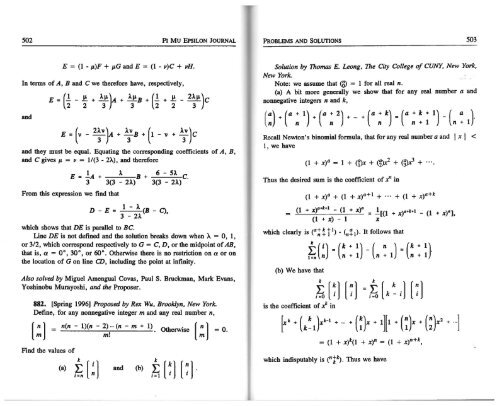Vol. 10 No 6 - Pi Mu Epsilon
Vol. 10 No 6 - Pi Mu Epsilon
Vol. 10 No 6 - Pi Mu Epsilon
- No tags were found...
You also want an ePaper? Increase the reach of your titles
YUMPU automatically turns print PDFs into web optimized ePapers that Google loves.
502 PI MU EPSILON JOURNAL<br />
PROBLEMS AND SOLUTIONS 503<br />
E = (1 - p.)F + p.G and E = (1 - 11)C + 11H.<br />
In terms of A, B and C we therefore have, respectively,<br />
E = (! - ~ + 1 ~)A + 1~ B + (! + ~ - 21 ~ )c<br />
2 2 3 3 2 2 3<br />
and<br />
E = ( v - 2~ v )A + 13v B + ( 1 - v + 13v) C<br />
and they must be equal. Equating the corresponding coefficients of A, B,<br />
and C gives p. = " = 11(3 - 2X), and therefore<br />
1<br />
E =-A+ 1 B + --=-6 _-.....;5~1:....._c.<br />
3 3(3 - 21) 3(3 - 21)<br />
From this expression we find that<br />
D-E= 1 -<br />
1 (B-C)<br />
3 - 21 '<br />
which shows that DE is parallel to BC.<br />
Line DE is not defined and the solution breaks down when ).. = 0, 1,<br />
or 3/2, which correspond respectively toG= C, D, or the midpoint of AB,<br />
that is, a = 0°, 30°, or 60°. Otherwise there is no restriction on a or on<br />
the location of G on line CD, including the point at infinity.<br />
Also solved by Miguel Amengual Covas, PaulS. Bruckman, Mark Evans,<br />
Yoshinobu <strong>Mu</strong>rayoshi, and the Proposer.<br />
882. [Spring 1996] Proposed by Rex Wu, Brooklyn, New York.<br />
Define, for any nonnegative integer m and any real number n,<br />
Solution by Thomas E. Leong, The City College of CUNY, New York,<br />
New York.<br />
<strong>No</strong>te: we assume that ® = 1 for all real n.<br />
(a) A bit more generally we show that for any real number a and<br />
nonnegative integers n and k,<br />
Recall Newton's binomial formula, that for any real number a and I x I <<br />
1, we have<br />
(1 + x)a = 1 + x + (~~ + (~~ +<br />
Thus the desired sum is the coefficient of X' in<br />
(1 + x)a + (1 + x)a+ 1 + · · · + (1 + x)a+k<br />
(1 ) a+k+l (1 )a 1<br />
= + X - + X = -((1 + X)a+k+l _ (1 + X)a),<br />
(1 + x) - 1 x<br />
which clearly is (a!! t 1 ) -
















